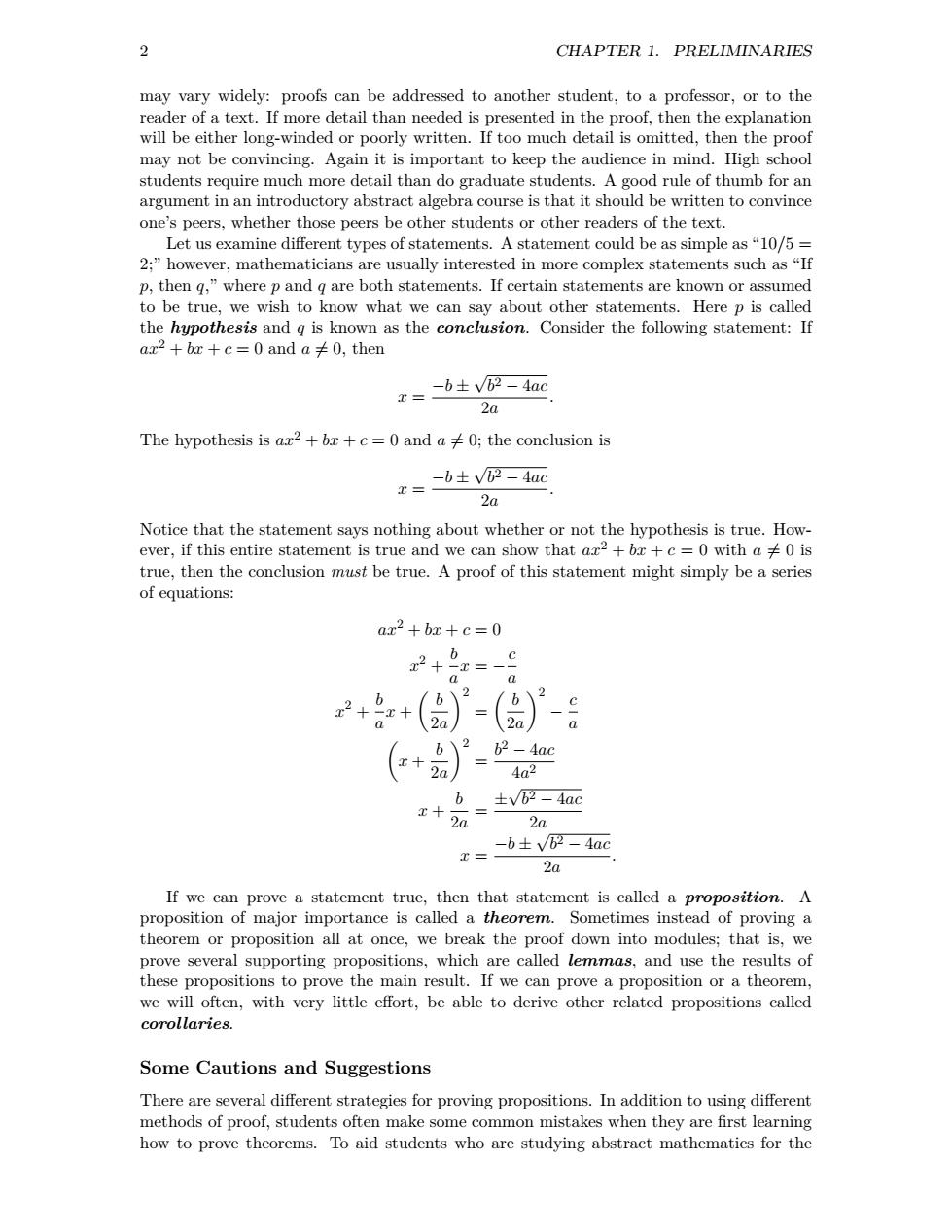正在加载图片...

2 CHAPTER 1.PRELIMINARIES may vary widely:proofs can be addressed to another student,to a professor,or to the reader of a text.If more detail than needed is presented in the proof,then the explanation will be either long-winded or poorly written.If too much detail is omitted,then the proof may not be convincing.Again it is important to keep the audience in mind.High school students require much more detail than do graduate students.A good rule of thumb for an argument in an introductory abstract algebra course is that it should be written to convince one's peers,whether those peers be other students or other readers of the text. Let us examine different types of statements.A statement could be as simple as"10/5 2;"however,mathematicians are usually interested in more complex statements such as "If p,then q,"where p and q are both statements.If certain statements are known or assumed to be true,we wish to know what we can say about other statements.Here p is called the hypothesis and g is known as the conclusion.Consider the following statement:If a.x2+bx+c=0anda≠0,then x=-b±V6-4ac 2a The hypothesis is ax2+bx+c=0 and a0;the conclusion is x=-b±V-4ac 2a Notice that the statement says nothing about whether or not the hypothesis is true.How- ever,if this entire statement is true and we can show that ax2+bx+c=0 with a 0 is true,then the conclusion must be true.A proof of this statement might simply be a series of equations: ax2+bx+c=0 b x2+0x=- a a b /b12 b 2 22 a 2a/ 2a a b 2 62-4ac z+ 2a 4a2 b ±V2-4ac E十 2a 2a -b±v2-4ac x= 2a If we can prove a statement true,then that statement is called a proposition.A proposition of major importance is called a theorem.Sometimes instead of proving a theorem or proposition all at once,we break the proof down into modules;that is,we prove several supporting propositions,which are called lemmas,and use the results of these propositions to prove the main result.If we can prove a proposition or a theorem, we will often,with very little effort,be able to derive other related propositions called corollaries. Some Cautions and Suggestions There are several different strategies for proving propositions.In addition to using different methods of proof,students often make some common mistakes when they are first learning how to prove theorems.To aid students who are studying abstract mathematics for the2 CHAPTER 1. PRELIMINARIES may vary widely: proofs can be addressed to another student, to a professor, or to the reader of a text. If more detail than needed is presented in the proof, then the explanation will be either long-winded or poorly written. If too much detail is omitted, then the proof may not be convincing. Again it is important to keep the audience in mind. High school students require much more detail than do graduate students. A good rule of thumb for an argument in an introductory abstract algebra course is that it should be written to convince one’s peers, whether those peers be other students or other readers of the text. Let us examine different types of statements. A statement could be as simple as “10/5 = 2;” however, mathematicians are usually interested in more complex statements such as “If p, then q,” where p and q are both statements. If certain statements are known or assumed to be true, we wish to know what we can say about other statements. Here p is called the hypothesis and q is known as the conclusion. Consider the following statement: If ax2 + bx + c = 0 and a ̸= 0, then x = −b ± √ b 2 − 4ac 2a . The hypothesis is ax2 + bx + c = 0 and a ̸= 0; the conclusion is x = −b ± √ b 2 − 4ac 2a . Notice that the statement says nothing about whether or not the hypothesis is true. However, if this entire statement is true and we can show that ax2 + bx + c = 0 with a ̸= 0 is true, then the conclusion must be true. A proof of this statement might simply be a series of equations: ax2 + bx + c = 0 x 2 + b a x = − c a x 2 + b a x + ( b 2a )2 = ( b 2a )2 − c a ( x + b 2a )2 = b 2 − 4ac 4a 2 x + b 2a = ± √ b 2 − 4ac 2a x = −b ± √ b 2 − 4ac 2a . If we can prove a statement true, then that statement is called a proposition. A proposition of major importance is called a theorem. Sometimes instead of proving a theorem or proposition all at once, we break the proof down into modules; that is, we prove several supporting propositions, which are called lemmas, and use the results of these propositions to prove the main result. If we can prove a proposition or a theorem, we will often, with very little effort, be able to derive other related propositions called corollaries. Some Cautions and Suggestions There are several different strategies for proving propositions. In addition to using different methods of proof, students often make some common mistakes when they are first learning how to prove theorems. To aid students who are studying abstract mathematics for the